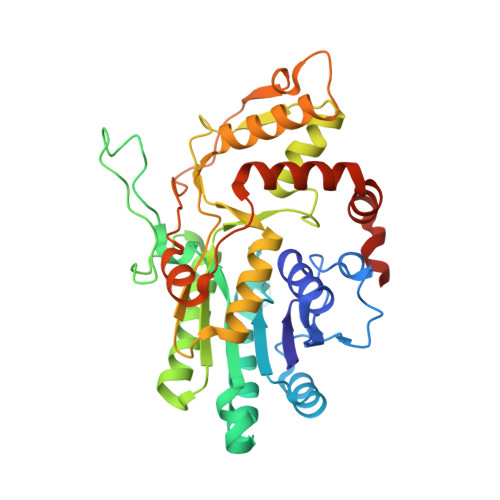The crystal structure of dTDP-D-Glucose 4,6-dehydratase (RmlB) from Salmonella enterica serovar Typhimurium, the second enzyme in the dTDP-l-rhamnose pathway.
Allard, S.T., Giraud, M.F., Whitfield, C., Graninger, M., Messner, P., Naismith, J.H.(2001) J Mol Biology 307: 283-295
- PubMed: 11243820
- DOI: https://doi.org/10.1006/jmbi.2000.4470
- Primary Citation of Related Structures:
1G1A - PubMed Abstract:
l-Rhamnose is a 6-deoxyhexose that is found in a variety of different glycoconjugates in the cell walls of pathogenic bacteria. The precursor of l-rhamnose is dTDP-l-rhamnose, which is synthesised from glucose- 1-phosphate and deoxythymidine triphosphate (dTTP) via a pathway requiring four enzymes. Significantly this pathway does not exist in humans and all four enzymes therefore represent potential therapeutic targets. dTDP-D-glucose 4,6-dehydratase (RmlB; EC 4.2.1.46) is the second enzyme in the dTDP-L-rhamnose biosynthetic pathway. The structure of Salmonella enterica serovar Typhimurium RmlB had been determined to 2.47 A resolution with its cofactor NAD(+) bound. The structure has been refined to a crystallographic R-factor of 20.4 % and an R-free value of 24.9 % with good stereochemistry.RmlB functions as a homodimer with monomer association occurring principally through hydrophobic interactions via a four-helix bundle. Each monomer exhibits an alpha/beta structure that can be divided into two domains. The larger N-terminal domain binds the nucleotide cofactor NAD(+) and consists of a seven-stranded beta-sheet surrounded by alpha-helices. The smaller C-terminal domain is responsible for binding the sugar substrate dTDP-d-glucose and contains four beta-strands and six alpha-helices. The two domains meet to form a cavity in the enzyme. The highly conserved active site Tyr(167)XXXLys(171) catalytic couple and the GlyXGlyXXGly motif at the N terminus characterise RmlB as a member of the short-chain dehydrogenase/reductase extended family. The quaternary structure of RmlB and its similarity to a number of other closely related short-chain dehydrogenase/reductase enzymes have enabled us to propose a mechanism of catalysis for this important enzyme.
- Centre for Biomolecular Sciences, The University, North Haugh, St Andrews Fife, KY16 9ST, Scotland.
Organizational Affiliation:


















